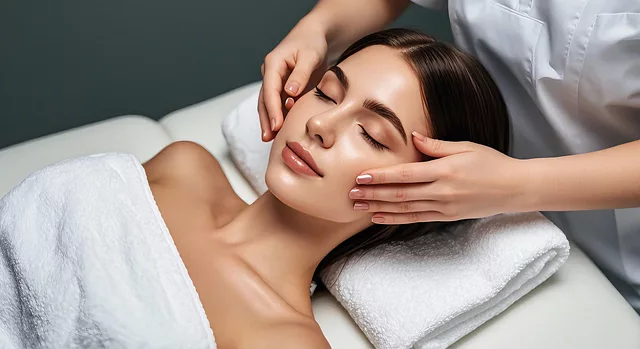Facial fillers, a popular cosmetic procedure, enhance features and reverse aging by injecting substances like hyaluronic acid or collagen into specific areas. Under-eye fillers, leveraging these technologies, combat volume loss and fine lines in the delicate eye region. They offer benefits like reducing wrinkles, brightening dark circles, enhancing symmetry, and correcting hollow eyes, appealing to those seeking a refreshed look without surgery. Selection should match specific needs, with hyaluronic acid providing immediate but temporary results, while collagen stimulators promote natural production for longer-lasting effects. The procedure is quick, non-invasive, with minimal discomfort, and regular touch-ups are recommended. Administered by qualified professionals, under-eye fillers offer safe, effective results with potential side effects like redness or swelling, lasting 6 to 18 months.
“Unveil a rejuvenated gaze with under-eye fillers—a popular aesthetic trend in the realm of facial fillers. This non-invasive procedure offers a solution for dark circles, fine lines, and fat loss below the eyes. In this comprehensive guide, we’ll take you on a journey through the world of facial fillers, focusing specifically on their science, benefits, and what to expect during and after treatment. From understanding the ingredients to choosing the right product for your needs, and navigating recovery, we’ve got you covered.”
Understanding Facial Fillers: An Overview

Facial fillers are a popular and effective cosmetic procedure used to enhance facial features and reverse signs of aging. They work by injecting a substance into specific areas of the face, adding volume and smoothing out fine lines and wrinkles. These fillers can be made from various materials, including hyaluronic acid, collagen, and synthetic substances, each offering unique benefits and longevity.
Understanding how facial fillers function is essential for anyone considering this treatment. The procedure involves a simple process where a small amount of the filler is injected into the target area using fine needles. This stimulation prompts the body to produce more collagen, resulting in improved skin texture and reduced appearance of wrinkles. With their ability to provide immediate results and offer a non-invasive approach, facial fillers have become a go-to solution for many seeking a youthful and refreshed complexion.
The Science Behind Under-Eye Fillers

The science behind under-eye fillers involves a complex interplay of anatomy and biomaterials. Facial fillers, including those designed for the delicate under-eye area, are used to restore volume loss and minimize the appearance of fine lines and wrinkles. These treatments work by strategically placing small amounts of filler substances—often derived from hyaluronic acid, collagen, or synthetic materials—into the skin to plump and lift specific areas.
The under-eye region is particularly challenging due to its thin skin and high mobility. Specialized under-eye fillers are formulated to address these unique characteristics, ensuring they integrate seamlessly with the surrounding tissue while providing immediate and long-lasting results. Advanced techniques and a nuanced understanding of facial anatomy allow for precise injections, minimizing risks of unwanted side effects and ensuring natural-looking enhancements.
Benefits and Applications of Under-Eye Fillers

Under-eye fillers offer a myriad of benefits, making them a popular choice in cosmetic enhancement. One of their primary advantages is the significant improvement they bring to the appearance of fine lines and wrinkles that often develop around the delicate eye area. By adding volume and hydration, these fillers smoothen out signs of aging, providing a more youthful and rested look. They also play a crucial role in brightening dark circles by reducing the depth of depression caused by lack of fat and tissue under the eyes.
In terms of applications, under-eye fillers are versatile. They can be used to enhance overall facial symmetry by correcting any asymmetries below the eyes. Moreover, they effectively conceal puffiness and promote a more alert appearance. For individuals with hollow or sunken eyes, fillers can fill in these areas, offering a more balanced and youthful contour. This simple yet powerful procedure is often sought after by those aiming to achieve a refreshed look without extensive surgery.
Choosing the Right Under-Eye Filler for Your Needs

When considering under-eye fillers, it’s crucial to match your choice with specific needs and desired outcomes. The right facial filler for your undereye area can significantly reduce dark circles, smoothen fine lines, and enhance overall appearance. Different fillers cater to various concerns—some are ideal for volume restoration, while others focus on skin texture improvement or hydration.
Factors like skin type, severity of dark circles or wrinkles, and desired longevity should guide your selection. Hyaluronic acid fillers, for instance, offer a temporary yet immediate result, making them perfect for those seeking quick improvements. Collagen stimulators, on the other hand, promote natural collagen production for longer-lasting effects. Understanding these options allows you to make an informed decision, ensuring optimal results with your chosen facial filler.
Procedure, Recovery, and Maintenance

The procedure for under-eye fillers is relatively quick and non-invasive. A qualified dermatologist or aesthetic specialist will inject a small amount of filler into the desired areas, carefully targeting specific muscles and tissues to reduce the appearance of fine lines and wrinkles. The most common types of facial fillers used for this purpose are hyaluronic acid-based products, known for their ability to hydrate and plump the skin.
Recovery time is typically brief, with many patients experiencing minimal discomfort. Swelling and redness may occur immediately after the treatment but usually subside within a few days. It’s important to follow post-procedure instructions, which may include avoiding strenuous activities, direct sunlight, and certain cosmetics for a specified period. Regular touch-ups are often recommended to maintain the desired results, with treatments typically every 6-12 months, depending on the filler type and individual factors.
Safety, Side Effects, and Longevity

Under-eye fillers are a popular choice among those seeking to combat the signs of aging, but it’s crucial to understand the safety profile and potential side effects before undergoing this procedure. Facial fillers, including those used for the under-eye area, are generally considered safe when administered by a qualified professional. However, as with any cosmetic treatment, there are risks. Common side effects may include redness, swelling, bruising, and temporary discomfort at the injection site. In rare cases, patients may experience more severe reactions, such as infection or an allergic response.
The longevity of under-eye fillers varies depending on several factors, including the type of filler used, individual anatomy, and lifestyle choices. On average, results can last between 6 to 18 months. Some fillers degrade slowly over time, providing a gradual correction, while others are designed for faster resorption. It’s essential to discuss these details with your practitioner to set realistic expectations and determine the best treatment plan tailored to your needs.
